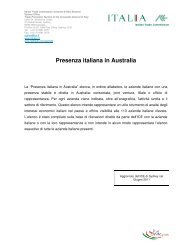Price Determination in the Australian Food Industry A Report
Price Determination in the Australian Food Industry A Report
Price Determination in the Australian Food Industry A Report
Create successful ePaper yourself
Turn your PDF publications into a flip-book with our unique Google optimized e-Paper software.
Figure 68. Processed frozen vegetables: Major drivers of prices and costs<br />
The processed frozen vegetable sector is dom<strong>in</strong>ated by two major <strong>in</strong>ternational processors <strong>in</strong> several categories. The product<br />
category rema<strong>in</strong>s under pressure from actual and potential imports of product at processed or f<strong>in</strong>ished goods stages.<br />
1. Farm production factors<br />
• Stable volumes of production.<br />
• Seasonality of production is tightly<br />
controlled through terms of supply<br />
contracts between grower and<br />
processor.<br />
• <strong>Price</strong>s limited by strong market power<br />
of <strong>the</strong> processors.<br />
• Products have high perishability,<br />
pick<strong>in</strong>g schedules are structured to<br />
prevent need for storage.<br />
• High barriers to entry <strong>in</strong> terms of<br />
skill, customer contracts and capital<br />
outlay for land and equipment.<br />
2. Value-cha<strong>in</strong> <strong>in</strong>tegration<br />
• Majority of farm supply is under contract<br />
with tight controls over <strong>the</strong> tim<strong>in</strong>g and<br />
volumes of supply.<br />
• Limited <strong>in</strong>tegration of activities along <strong>the</strong><br />
cha<strong>in</strong>.<br />
• Increas<strong>in</strong>g scale efficiency <strong>in</strong> certa<strong>in</strong><br />
sectors of farm production and <strong>in</strong><br />
vegetable process<strong>in</strong>g.<br />
• Tight concentration of ownership of<br />
processed food operations.<br />
3. The market<strong>in</strong>g approach<br />
• Local <strong>in</strong>dustry is dom<strong>in</strong>ated by<br />
<strong>in</strong>ternational manufacturers and<br />
brand marketers.<br />
• Increas<strong>in</strong>g differentiation of frozen<br />
products for retail and food<br />
service sectors tailored to a wider<br />
range of convenience cook<strong>in</strong>g<br />
needs (for example, stirfry<br />
comb<strong>in</strong>ations).<br />
• Product market<strong>in</strong>g cont<strong>in</strong>ues to<br />
aim at a convenience <strong>the</strong>me to<br />
avoid wastage of fresh product <strong>in</strong><br />
kitchens.<br />
Imports<br />
Farm production<br />
Process<strong>in</strong>g<br />
Market<strong>in</strong>g<br />
Retail<br />
Distribution<br />
<strong>Food</strong> service<br />
4. Regulation and<br />
compliance<br />
• Increas<strong>in</strong>g costs of do<strong>in</strong>g<br />
bus<strong>in</strong>ess <strong>in</strong> farm<br />
enterprises to meet<br />
environmental, product<br />
<strong>in</strong>tegrity and food safety<br />
demands.<br />
• Tight concentration of<br />
process<strong>in</strong>g sector –<br />
limited scope for fur<strong>the</strong>r<br />
rationalisation to<br />
enhance profitability.<br />
5. Trade impacts<br />
• Imports have access to<br />
significant portion of markets<br />
<strong>in</strong> certa<strong>in</strong> segments (for<br />
example, peas).<br />
• Majority of frozen imports are<br />
packed <strong>in</strong> private label<br />
products or packed <strong>in</strong> local<br />
plants – this places limits on<br />
domestic processed prices<br />
<strong>in</strong>to retail.<br />
• Pressure from <strong>the</strong> potential to<br />
import frozen potato products<br />
keeps pressure on local<br />
wholesale returns to<br />
processors.<br />
6. Technology and <strong>in</strong>novation<br />
• High level of capital <strong>in</strong>tensity<br />
<strong>in</strong> harvest<strong>in</strong>g, grad<strong>in</strong>g and<br />
process<strong>in</strong>g stages.<br />
• Limited <strong>in</strong>novation <strong>in</strong> varieties<br />
for process<strong>in</strong>g.<br />
• Limited transparency of<br />
market prices and <strong>in</strong>formation<br />
beyond <strong>the</strong> farmgate due to<br />
tight concentration of <strong>the</strong><br />
sector.<br />
• Greater <strong>in</strong>vestment <strong>in</strong><br />
<strong>in</strong>novation to diversify core<br />
products and extract value<br />
from co-products (potato<br />
gems, hash browns) –<br />
especially <strong>the</strong> case <strong>in</strong><br />
potatoes for food service and<br />
vegetables prepared for<br />
different end uses.<br />
7. Retail market dynamics<br />
• Growth <strong>in</strong> value-added<br />
frozen and ready meal and<br />
comb<strong>in</strong>ation products.<br />
• The growth of <strong>the</strong> private<br />
label <strong>in</strong> frozen products<br />
has put price pressure on<br />
branded products.<br />
• In potato segment, strong<br />
presence of quick service<br />
restaurants has expanded<br />
<strong>the</strong> category.<br />
• Quick service restaurant<br />
sector under pressure to<br />
re-<strong>in</strong>vent itself through<br />
consumer concerns on<br />
food and body health.<br />
• Greater demand for<br />
convenience and lifestyle<br />
solutions <strong>in</strong> meals and<br />
snacks<br />
• Greater retail<br />
concentration has resulted<br />
<strong>in</strong> strong marg<strong>in</strong> pressure.<br />
<strong>Price</strong> <strong>Determ<strong>in</strong>ation</strong> <strong>in</strong> <strong>the</strong> <strong>Australian</strong> <strong>Food</strong> <strong>Industry</strong> A <strong>Report</strong><br />
67







